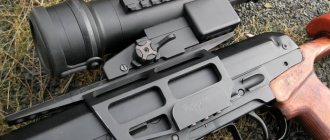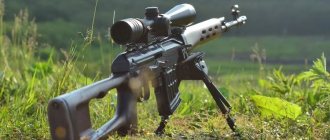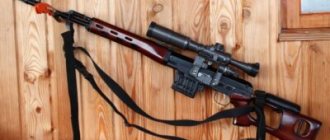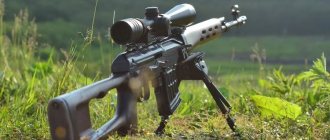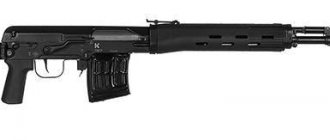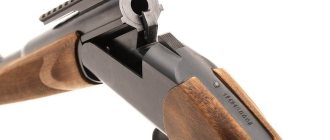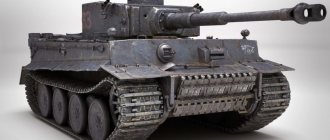The Tiger carbine is a self-loading hunting carbine, created on the basis of the Dragunov sniper rifle (SVD) and intended for hunting large and medium-sized animals. Produced in the city of Izhevsk (formerly IZHMASH). Various modifications of the Tiger carbine over the years were produced for cartridges: 7.62x54R, .308 Winchester, .30-06 Springfield and 9.3x64. Currently produced under the most popular cartridge 7.62x54R. The Tiger carbine is the most popular self-loading rifled carbine among hunters in Russia; it owes its popularity and prevalence to its unpretentiousness, simplicity of design and extreme reliability.
Story
The history of the Tiger carbine dates back to 1963, when, under the leadership of the famous firearms designer Evgeniy Dragunov, the Dragunov sniper rifle, better known under the abbreviated name SVD, was developed and put into production. The purpose of creating the SVD rifle was to create a weapon capable of replacing the sniper rifles, which were outdated by that time, based on the Mosin rifle.
In 1969, based on the SVD rifle E.F. Dragunov created the Tiger hunting carbine. The first samples were as similar as possible to the combat samples of the SVD. Until 1992, the Tiger carbine was produced in small quantities and mainly on special orders from the USSR Ministry of Defense.
Serial production of the Tiger carbine began at the Izhevsk Machine-Building Plant (Izhmash) in 1992; currently the Izhmash plant is part of Kalashnikov Concern JSC.
In 1996, the first modification of the carbine was created, which received the designation “Tiger-01”; it was designed for sale on the American market and was adapted to its requirements.
In all subsequent years, the plant launched into production new modifications of the Tiger carbine, which differ from each other in the type of stock, barrel length and other design differences. In addition to the production of the Tiger carbine chambered for 7.62x54, the plant also mastered the production of carbine chambered for .308 Win, .30-06 Sprg and 9.3x64 mm.
Shooting and cleaning
Zeroing a carbine begins with choosing suitable ammunition, since they all differ from each other in destructive power. For maximum effect, it is recommended to try several types to find the right one. If you don't know where to start, then opt for standard military ammunition.
After this, you need to install a square paper target with sports markings and fire three shots at it from a Tiger-308 carbine from a short distance (20-30 meters). If you shoot an optical sight right away, its magnification should always be increased to the maximum. We determine the average point of impact and see how much the aiming point differs from it. We make the appropriate adjustments and repeat the procedure.
After this, you need to repeat the same thing, but at a greater distance. We place the target at 50 meters and fire three shots, after which we adjust the sight. It is highly not recommended to adjust the vertical and horizontal at the same time, since this way you increase the likelihood of getting confused in the process and spending more time and ammunition on zeroing.
To zero an optical sight from a distance of more than 100 meters, it is recommended to use a special locking machine that holds the rifle in a stationary position. If this option is not available, then a bipod, a sandbag, or any convenient horizontal surface will serve as a support. The most important thing is to breathe correctly. Listen to the rhythm of your heart and take shots between beats as you exhale. Finger movements should be smooth and slow.
Cleaning a rifle is a fairly important procedure, since it determines how long the weapon will last. The procedure is carried out in a traditional, simple way. First, you need to partially disassemble the carbine, then moisten the cleaning rod in gun oil and clean not only the muzzle hole, but also all mechanisms contaminated with gunpowder. Never use folding or plastic cleaning rods, as they bend greatly during use and can leave unwanted scratches on the muzzle.
Differences between the Tiger carbine and SVD
- The barrel length of the Tiger carbine can be 530 or 620 mm, depending on the modification, while the SVD has a barrel length of only 620 mm.
- The rifling pitch for the Tiger carbine is 320 mm, for the SVD it is 240 mm.
- The cartridge of the Tiger carbine has a control groove, which serves for ballistic identification of the weapon.
- The Tiger carbine does not have a gas regulator on the gas tube.
- The SVD sighting bar provides for shooting up to 1200 m, the Tiger carbine sighting bar is marked up to a shooting distance of up to 300 m.
- The front sight block of the Tiger carbine has a different design from the front sight block of the SVD rifle.
- The SVD has a magazine for 10 rounds, the Tiger carbine can be equipped with a magazine for 5 or 10 rounds, depending on the modification.
- The flash suppressor-compensator of the Tiger carbine is shorter than that of the SVD rifle.
- The Tiger carbine does not have a bayonet stop.
- The Tiger carbine has a changed shape of the swivel on the barrel.
Specifications
The Tiger carbine has the following technical characteristics:
- Type:
self-loading carbine, operating on the principle of using the removal of part of the powder gases from the barrel - Caliber:
7.62x54R, 308Win (7.62x51), 30-06Sprg (7.62x63), 9.3x64 mm - Barrel length:
530 mm (chambered 7.62x54R) - 565 mm (chambered .308Win, .30-06Sprg, 9.3x64 mm)
- 620 mm (on order, chambered for 7.62x54R .308Win, .30-06Sprg, 9.3x64 mm)
detachable 5-round magazine, 10-round magazine can be installed
300 m
- 1095 mm (with a barrel length of 530 mm)
3.8-3.9 kg
The total length and weight of the Tiger carbine depend on the modification, design, type of stock, and the presence or absence of a flash suppressor.
Modification
The Tiger-308 SVD is quite similar to military weapons, so modification can be carried out using most of the same accessories that are in service with special forces. Tuning a carbine is usually carried out in order to improve the technical characteristics of the weapon or give it a more beautiful appearance. To do this, you can use optical and collimator sights, under-barrel lights, original paint and all sorts of structural parts made of expensive metals. Such a carbine becomes not only a good weapon, but also an expensive souvenir.
Design of the Tiger carbine
Trunk
The Tiger carbine has a barrel length of 530 mm; there are also modifications of the carbine with a barrel length of 565 and 620 mm. The bore and chamber are chrome-plated to increase service life and simplify maintenance and cleaning. The chamber has a ballistic mark. The barrel has four grooves, two of them are 4.55 mm wide, two are 5.05 mm wide. The shape, width and profile of the rifling of the Tiger carbine differs from the shape, width and profile of the rifling of the SVD rifle; this was done at the request of the Ministry of Internal Affairs of the Russian Federation, for identification during forensic examination. These changes do not affect shooting characteristics.
The barrel of the SVD rifle and Tiger carbine is manufactured using a unique technology. The barrel blank is drilled, then reamed twice. Then the bore of the future barrel is subjected to the process of electrochemical polishing (ECP), during which the remaining roughness after deployment is melted. The barrel is then rifled using an electrochemical machining (ECM) process. A cathode with a pattern and angle of the rifling fields is inserted into the barrel bore. A current is passed through the cathode, and a special liquid is passed through the barrel bore. During the electrochemical machining process, the metal of the workpiece is washed out according to the rifling pattern. After making the rifling, the barrel blank is ground to the required external dimensions, then the barrel bore and chamber are chrome-plated.
The length of the barrel rifling can be 240 or 320 mm. Most modifications of the Tiger carbine have a rifling pitch of 320 mm; this rifling pitch allows for accurate shooting with heavy hunting bullets. The barrel of the Tiger carbine does not undergo cryogenic strengthening of the barrel and electrochemical polishing of the chrome coating, so the barrel life of the Tiger carbine is 4000 shots, unlike the SVD, which has a much longer barrel life of 10,000 shots.
At the end of the barrel of the Tiger carbine there is a thread for installing a flash suppressor. The Tiger carbine can be equipped with different types of flame arresters: short and long, conical and slotted. The flash suppressor reduces the visibility of the shot and reduces the formation of dust and gases when fired.
Shutter and automation
The Tiger carbine is a self-loading rifle that operates on the principle of using the energy of powder gases from the barrel.
The gas mechanism is located above the barrel, it is designed to remove gases from the barrel bore, and consists of a short-stroke gas piston and a gas tube.
Inside the receiver there is a bolt frame, a return spring and a trigger mechanism. The bolt frame receives the impact of powder gases from the gas piston through the pusher. When the bolt frame moves back, it cocks the firing mechanism. The bolt frame has a reloading handle. When the bolt carrier reaches the extreme point of recoil, it is acted upon by a compressed recoil spring. The force of the spring pushes the frame forward, the bolt rotates and grabs the next cartridge from the magazine, sending it into the chamber, the bolt rotates all the way, locking the barrel.
The carbine bolt has a rotating cylinder and has three lugs. The barrel bore is locked by turning the bolt cylinder to the left. Three lugs securely lock the barrel and ensure a stable bolt position.
All automatic parts of the Tiger carbine have a low mass and low energy in extreme positions, all this gives minimal deflection of the carbine when fired, quick recovery of aiming and ensures a high rate of fire of the carbine. When all the cartridges in the magazine are used up, the bolt of the carbine is locked into the bolt stop.
USM
The trigger mechanism of the Tiger carbine is assembled in a separate removable housing, ensures the firing of a shot only when the bolt is completely locked and allows only single fire. The trigger mechanism is unregulated.
The Tiger carbine has a flag-type safety, which simultaneously blocks the trigger sear and the rearward movement of the bolt frame.
Sights
The Tiger carbine has open mechanical sights consisting of a rear sight and a front sight. The front sight is non-adjustable, in a closed block, on a high bracket. There are modifications of the carbine with a height-adjustable front sight.
The rear sight is adjustable, with a distance ruler. Depending on the modification of the carbine, the notch of the distance ruler can be up to 300 or up to 1200 meters. When shooting from a Tiger carbine, do not forget that effective shooting from it with open sights with hunting cartridges is possible at a distance of up to 250-350 meters.
The receiver of the Tiger carbine has two dovetail strips for mounting optical, collimator and night sights and other additional equipment, one of the straps is located on top of the receiver and one on the side. The standard optical sights for the Tiger carbine are the PSO-1 and PO4x32 sights.
An adapter bracket with a dovetail mount and a transition to a Weaver or Picatinny rail, or quick-change brackets, is often installed on the receiver rail. Such brackets can be used to mount almost any sight on a carbine. Installation of the body kit on the receiver cover is limited by its design; it is removable; in addition, installing a bar on top of the receiver covers the open sight.
Shop
The Tiger carbine feeds cartridges from a detachable, double-stack, box magazine. The standard metal magazine for the Tiger holds 5 rounds. There are carbines equipped from the factory with a metal magazine for 10 rounds. If desired, you can find lighter magazines made of polyamide on sale, which can be of different capacities.
Butt
The Tiger carbine, depending on the modification, can be equipped with a different type of stock: folding metal, plastic or wooden.
A metal folding stock is convenient because when the stock is folded, the dimensions of the carbine are significantly reduced and it is more convenient to transport and carry.
Wooden stocks have a more aesthetic appearance, provide better balance to the carbine while aiming, and better dampen barrel vibration, thereby increasing shot accuracy. The material of the wooden stock is most often birch or beech. The wooden butt for the Tiger carbine can be of different types: in the form of an orthopedic butt with a hole for the thumb, in the form of a hunting butt with a pistol neck, in the form of a wooden laminated butt.
Plastic stocks have an aesthetic appearance and have maximum practicality compared to stocks made from other materials.
To make it easier to hold the carbine when shooting and to protect your hands from burns, the Tiger carbine has a forend, consisting of two plates, covering the gas tube and barrel. The forend pads, depending on the modification of the carbine, can be made of wood, laminated plywood or polyamide.
Barrel manufacturing technology
The Tiger barrel is created using the same technology as for SVD rifles. First, a high-quality steel workpiece is drilled, then the channel is reamed twice. Semi-finishing and finishing. This achieves the highest possible roughness during machining.
After this, the remaining roughness after reaming is melted by electric discharge, during the so-called electrochemical polishing process (ECP). And only then comes the time for the procedure for making rifling using electrochemical processing (ECM).
A cathode with a pattern and angle of the rifling fields is inserted into the finished polished channel. Current is passed through the cathode and coolant passes through the channel. During electrochemical processing, the metal of the workpiece is washed out according to the rifling pattern. This achieves high processing speed and purity. After making the rifling, the channel is washed, and the workpiece is externally turned to the required dimensions. Then the surface of the rifling and the channel itself are chrome-plated.
These operations made it possible to achieve high quality barrel processing and its durability.
Modifications and versions of the Tiger carbine
Carbine Tiger 7.62x54R
The most popular and widespread version of the carbine. This is a fairly old cartridge, known since the days of the Mosin rifle. The weight of the bullet is, as a rule, 13-13.2 grams. Muzzle energy of the cartridge is 3600 Joules. The initial bullet speed is 780 m/s. The 7.62x54R cartridge allows you to kill an elk at a distance of up to 250 meters.
"Tiger - 308"
The Tiger-308 carbine is designed for use with the 308Win cartridge (7.62x51mm). This cartridge is a very common type of ammunition; all well-known manufacturers of rifled cartridges have this cartridge in their assortment. Bullet weight can be from 6.0 to 14.8 grams. Muzzle energy 3700 Joules, for a cartridge with a bullet of 11.7 grams, at a bullet speed of 800 m/s. The length of the carbine barrel is 565 mm, on special order 620 mm. Magazine for 10 rounds. It can be equipped with a wooden hunting stock or a folding stock of the SVDS type. The weight of the carbine is from 4 to 4.2 kg. The length of the carbine with a conventional butt is from 1095 to 1155 mm, with a folding stock 880 mm. This version of the carbine is of great interest to hunters due to its high versatility of use.
"Tiger-30-06"
The Tiger-30-06 carbine is designed for use with the .30-06 Sprg (7.62x63mm) cartridge. The length of the carbine barrel is 565 mm, on special order 620 mm. 5-round magazine. Can be equipped with a wooden hunting stock or a folding tubular stock. The weight of the carbine is 3.9 kg. The length of the carbine with a conventional butt is from 1115 to 1175 mm.
"Tiger-9"
"Tiger-9" is the most powerful version of the Tiger carbine. Carbine cartridge "Tiger-9": 9.3x64 mm. Quarabine production began in 1999. The Tiger-9 cartridge has a muzzle energy of 5800 Joules, with a bullet speed of 820 m/s. The weight of the carbine is 4 kg. The length of the carbine barrel is 565 mm, on special order 620 mm. It can be equipped with a wooden hunting stock or a folding stock of the SVD type. 5-round magazine. The Tiger-9 carbine is designed for hunting large wild boar, elk hunting, bear hunting, at a distance of up to 100-150 meters. The optical sight installed on the Tiger-9 must withstand high loads when firing.
Versions of the Tiger carbine
Over many years of production, the plant produced the Tiger carbine in various designs, differing in some design features:
- The "Tiger" carbine, version (Spanish) 01, has a bar on the left side of the receiver for mounting optics. The butt of this modification consists of two metal tubes, on the top of which there is a rotating cushion. A long flash suppressor is installed on the barrel, which more effectively dampens recoil.
- Carbine "Tiger" in Spanish. 02 – differs from other modifications by the presence of a folding metal stock, similar to the SVDS stock. When folding the stock, the trigger mechanism is blocked; this is done for safety purposes.
- Carbine "Tiger" in Spanish. 03 – a carbine of this design has a wooden butt made of beech or birch, the butt has a Monte Carlo type cushion, and there is a recess on the neck of the butt stock for a comfortable hand position when shooting.
- Carbine "Tiger" in Spanish. 04 is a non-self-loading modification of the carbine; to reload, after each shot you need to jerk the bolt handle.
- The Tiger carbine version 05 is the closest approximation to the SVD rifle. Orthopedic stock made of laminated wood. It is possible to install a barrel with a length of 620 mm, like the SVD. Long cylindrical flame arrester.
Operating principle
The carbine operates on the principle of removing part of the powder gases from the barrel:
- Above the barrel there is a gas cylinder, inside of which there is a gas piston.
- Powder gases from the barrel enter the gas cylinder through the hole and push the gas piston, which acts through the rod on the bolt frame.
- The bolt moves back, the bolt cylinder rotates and its stops disengage with the barrel breech. The spent cartridge case is ejected and the firing pin is cocked.
- The bolt, under the action of the return mechanism spring, moves forward, the cartridge is fed into the chamber, the bolt cylinder rotates and locks the bolt.
To charge the rifle, follow these steps:
- Press the magazine release and remove the magazine.
- Place the cartridges in the magazine in two rows, in a checkerboard pattern.
- Insert the magazine into the hopper.
- Remove the safety catch from the rifle, pull the bolt back vigorously and release.
- Put the safety on the carabiner.
Disassembly
In order to disassemble the carbine, you need to do the following:
- Disconnect the magazine from the carbine
- Check that there is no cartridge in the chamber, to do this, move the bolt, perform a control release
- Remove the receiver cover by pressing the short lever located to the left of its buttplate
- Pull out the return spring
- Slide the bolt carrier back and remove it from the receiver
- Remove the shutter cylinder by turning it clockwise
- Pull out the safety lever
- Remove the trigger
- Remove the barrel linings by sliding the barrel lining coupling forward
- Move the gas mechanism pusher back, remove the piston from the chamber
- Remove the gas mechanism pusher assembly with the spring
- The carbine is assembled in the reverse order.
Advantages
- The design of the Tiger carbine is old, time-tested, simple and highly reliable.
- Hunters note the good softness of the trigger of the carbine; such a trigger allows even novice hunters to shoot with good accuracy.
- The low price of the carbine, especially in comparison with foreign analogues, is still the main argument in its favor.
Advantages
Judging by the reviews of hunters, the Tiger-308 has a number of positive aspects:
- versatility;
- automatic recharge;
- resistance to harsh weather conditions;
- ease of use;
- reliability.
It is also worth adding to this list the relatively low cost of ammunition and the weapon itself. If you decide to purchase an imported analogue, you will not only spend a tidy sum on the carbine itself, but also go broke on branded cartridges during operation.
Flaws
- The Tiger carbine does not have very high accuracy. The self-loading principle of the rifle itself significantly reduces the accuracy of the weapon. Modern bolt action rifles are accurate to less than 1 MOA. The Tiger carbine has an accuracy of about 3 MOA, although some hunters say that with the right cartridge and shooting skills you can achieve significantly higher accuracy.
- The Tiger carbine, as already mentioned, is a civilian version of the SVD rifle, and unlike the SVD it has a shorter barrel and different widths of rifling pairs. All these changes worsened the accuracy and accuracy of the Tiger compared to the SVD.
- The fairly large weight of the carbine practically does not allow it to be used for running hunting.
- Limited number of calibers in which the carbine is produced. Calibers 7.62x54R, 308Win and 9x64 are designed for hunting large game and are not suitable for other hunts.
- The main caliber for the Tiger is 7.62x54R; this cartridge was created for military purposes and was not originally intended for hunting. This cartridge does not have sufficient stopping power to reliably defeat a large animal; if it hits the wrong place, wounded animals are possible, and when hunting a large animal this can be extremely dangerous.
- The automatic operation of the carbine, although it is simple and highly reliable, can malfunction if it is not properly maintained, especially during long-term hunting, or if the carbine is dropped into water or sand.
- The weak point of the carbine is the polyamide lining of the fore-end, which squeaks and makes your hands cold in the cold. Many hunters replace them with wooden ones.
- The cartridges in the magazine of the Tiger carbine can rattle when walking and thereby unmask the hunter; it is also often changed.
- The carbine safety makes a strong click when switching; when hunting from a tower or storage shed, the sound of the safety switch can frighten the animal.
- Hunters have an ambiguous opinion regarding the orthopedic butt of the carbine. Many hunters find it inconvenient; a regular hunting stock is better suited to the requirements.
Hunting with a Tiger rifle
The Tiger carbine has a fairly large mass, so its main purpose is hunting from ambush or storage sheds. It is not suitable for walking hunting.
The caliber of the carbine determines its main purpose: hunting large ungulates and predators.
Before hunting, you must shoot the carbine, selecting suitable cartridges for it. Typically, for hunting with a Tiger carbine, cartridges with semi-jacketed bullets are used. For zeroing, paper targets measuring 75x75 cm are used. The zeroing distance is determined depending on the conditions of the future hunt, usually 100, 150 or 200 meters.
A well-aimed Tiger carbine should ensure that it hits a circle with a diameter of 10 cm when shooting with an optical sight, and a circle with a diameter of 20 cm when shooting with open sights. These results will be quite sufficient for most hunts.
To understand whether the Tiger carbine is right for you, you need to have a good idea of why you are purchasing a rifled weapon, who you are going to hunt, in what way and under what conditions.
The Tiger carbine is well suited for driven hunting, for example when hunting wild boar or elk, when you often have to fire not one, but two or three shots in a row.
When hunting from a tower or storage shed, only one shot is needed; a bolt-action rifle is better suited for such hunting.
Choosing a scope depending on the type of hunting.
The Tiger carbine is not very different from the army SVD, which at one time was designed as additional fire support for a motorized rifle division. Firing distances were in the range of 300-600 meters. The hunting version also has similar characteristics, only the range can be expanded due to the standard distances of commercial hunts from 100 to 600 meters. The carbine has been in the hands of domestic hunters for over 40 years. During this time, many gun owners gained experience in hunting any type of animal. Moreover, the variety of cartridges covers the entire range. But it is worth noting that the Tiger has a small spread, which contributes to greater precision shooting at distances over 200 meters. This is what often influences the choice of hunters who want to get new hunting sensations after undergoing five years of training on a smoothbore. The carbine cannot be classified as a weapon for beginners, so the main types of hunting are associated with medium and long-range aiming. In such cases, the use of an optical sight is natural, but still depends on geographical factors. If, for example, a hunter shot at a wild boar, only because this particular animal predominated in the area, but later switched to rifled, the situation has not changed, in this case, they approach the selection of a scope from the other side - they select a lower magnification, or use a collimator.
The effective sighting range of the SVD rifle with the PSO sight on which military specialists “work” is no more than 650 meters. At the same time, the “passport” sighting range is twice as large: 1,300 meters. In a separate article we will analyze why this is so: “PSO. Sight No. 1 in the Soviet and Russian armies."
At medium and long shooting distances, the size of the animal must be taken into account. So, for example, when shooting with open sights at a distance of 200 meters, a standard elk covers almost the entire front sight of the Tiger. Read more about the intricacies of zeroing in the article at the link. Using magnification in the range of 3 to 10 times provides a more accurate shot. At the same time, the use of high magnifications also affects accuracy, since the increased magnification and considerable weight of the carbine aggravate the situation due to sensitivity to hand vibrations. It is for these reasons that additional accessories, such as bipods and claws for attaching bipods, are common.
Tuning the Tiger carbine
The Tiger carbine provides its owners with great opportunities for tuning. On sale you can find a large number of spare parts and various tuning elements for the Tiger. Most often, owners improve their carbine with the following tuning elements:
- An open mechanical sight is not suitable for accurate shooting at long distances, so many owners install an optical or night sight on their rifle. With this improvement, the firing range and accuracy significantly increases.
- Many owners of the Tiger carbine change the stock on it, since the original stock does not suit them in terms of height or other anthropometric data, or does not suit them for some other reason. Buttstocks for SVD rifles and Tiger carbines are produced by many domestic and foreign manufacturers.
- The original receiver linings are replaced with others that have a Picatinny rail or a Keymod interface. After such an upgrade, it will be possible to install additional equipment on the carbine: a flashlight, a bipod or a laser target designator.
- The effectiveness of the Tiger carbine can be seriously increased by installing a bipod on it. Bipods help well with target shooting, when hunting from a storage shed or a blind.
- A more effective flame arrester is placed on the barrel of the Tiger carbine, either from an SVD, or an externally simulating silencer. We should not forget that the manufacture and installation of a silencer on a Tiger carbine is illegal.
- Some owners replace the standard bolt handle with a more modern and ergonomic rubberized one.
- Many people put a shock-absorbing pad made of frost-resistant rubber on the butt of the carbine to soften the recoil.
Mounting options and the influence of brackets on the choice of sight
The main method of attaching sights to SVD and Tiger is the principle of installation on the side rail. All modifications of the carbine are supplied from the factory already with a bar. It is worth noting that of the various quick-release mount options used abroad, the side mount has the largest number of brackets produced. Moreover, this type can be classified as quick-detachable, reliable and, most importantly, does not allow sights to go astray. When the SVD is delivered to units, the rifle is equipped with a PSO sight, which has a cast bracket. For civilian use, the Novosibirsk Instrument-Making Plant produces the PO 4x24 sight, which is a complete analogue, with some important changes.
Difference between PSO and PO 4x24 sights:
| PSO | Software 4x24 | |
| Availability of rangefinder reticle | Yes | Yes |
| Size of object for measuring distances, m | 1.7 (human height) | 1.5 (height figure of a moose) |
| Availability of an option with a hunting net | No | Yes |
| IR Tracking | Yes | No |
The table shows that the differences are related to the target object. Naturally, the reticles for PSO were developed for shooting at enemy soldiers, and for the civilian version - at animals.
A PSO sight or software is considered very often when choosing an optical sight, since in fact the hunter receives optics with a monolithic bracket. But how to install any other sight that is not with a monolithic bracket? When selecting fastenings, you need to consider:
- sight mounting diameter
- lens outer diameter
The mounting diameter of the sight is most often 25.4 mm or 30 mm. This characteristic is always indicated in the name or brief characteristics of the bracket. But the outer diameter of the lens affects the height of the bracket. The larger the diameter of the lens, the higher the bracket is required, otherwise the sight may simply not stand up, for example, due to a protruding mechanical sight. Below, in the “bracket + sight” variations presented, we take these properties into account.
In this case, it is worth considering the influence of the butt on the placement of the sight. The standard stock was designed for shooting with an optical sight, but when aiming was carried out with an open sight, the hunters encountered the first problems, since the length of the stock was not enough. Many users, after purchasing a carbine, replaced plastic butts with original wooden ones, thereby moving the side landing bar away from the eye. Using side brackets with rings, it was not always possible to bring the sight closer to the optimal and safe distance. Based on this, a common method for installing sights on SVD (“Tiger”) is associated with an adapter bracket for the Weaver rail. Side mounting brackets for converting from a side mount to a top Weaver allow the scope to be positioned at different distances. Moreover, if the sight is used on several guns, or the optical sight is periodically replaced by a night sight or collimator, then the Weaver mount allows you to bring everything to a single base, thereby ensuring convenience when changing from one sight to another.
Installation and dismantling of a sight with an adapter bracket can be done as follows:
- the sight is removed from the Weaver rail, the side bracket remains on the gun
- the sight is removed together with the side bracket
However, if the scope is used for a specific type of hunting, we recommend installing it using a side bracket with rings. For many, consistency is key to accuracy, so the scope is removed on rare occasions, only when the gun is completely disassembled for cleaning. A special case of frequent dismantling of side brackets is the Tiger carbine with a folding butt.
As a result, depending on the tasks and method of hunting, two types of brackets are used:
- side bracket with monolithic rings
- adapter bracket for Weaver + rings
Regardless of the mounting type, the brackets may or may not have a quick-release latch. If we are talking about SVD, then quick release of the mount may be vital, but in the hunting sense it is only a matter of convenience, since there is enough time to dismantle and install any bracket. The comparison of the axis of the sight with the axis of the gun is also considered. According to theory, it is more convenient when these lines are located on top of each other. But for example, the army PSO is located to the left of the axis, since this allows you to simultaneously use an open sight.
Bracket options with Weaver strip:
Transition bracket Tiger Weaver (refinery)
One of the most popular brackets. In the middle price segment, the bracket has a quick-release latch; when installed, the Weaver rail is located below the mechanical sight. This bracket is supplied to special forces.
Side bracket Viper Weaver for Tiger, SVD (KS-TsF-1) H=66 mm low (Wind Rose)
The bracket was developed by Roza Vetrov engineers as an alternative to the Rassolov-Tarenkov brackets. The sight is made from a single piece of M45 steel. When installed, the Weaver rail completely coincides with the axis of the sight and is located below the mechanical sight.
Side bracket Viper Weaver for Tiger, SVD (KS-TsF1) H=76 mm high (Wind Rose)
Option of adapter bracket with increased height. Designed for permanent installation. The high position of the bar provides unobstructed access to the receiver cover, thus, when cleaning the weapon, complete dismantling of the sight with the bracket is not required.
Side bracket EST SVD-B
The SVD-B bracket from the Tula company EST was made of steel with the Weaver bar positioned low, and the adapter was installed quickly using a “flag” tightening system
Bracket SAG SVD/Tiger low
The version of the Weaver adapter bracket for SVD, Tiger from the SAG workshop is distinguished by its minimal weight - only 165 grams. It refers to a permanent installation type in which the seat plate is clamped by a plate with three hex screws. The low-mount option involves firing mechanically with the optics removed. Made from aircraft aluminum.
Pulsar Dіgіѕіght Ultra N455 LRF with laser rangefinder on SAG bracket
Options for brackets with rings:
Bracket KT 25.4 (EST), Bracket KT 30 (EST)
The bracket is made of steel, the clamping is carried out with a crank. The bracket stop is located at the front to accommodate the corresponding channel on the side bar. The axis of the sight coincides with the axis of the gun. Designed for sights with mounting diameters of 25.4 mm and 30 mm.
The bracket for installing sights on the Tiger from the TochPribor Central Design Bureau is available in 6 versions. Speaking earlier about the influence of the length of the butt, the bracket has the following varieties:
| Bracket Tiger 25.4 | Vertical, for 25.4 mm rings |
| Bracket Tiger 25.4 (-40) | Pull 40 mm towards the shooter's eye, under the rings 25.4 mm |
| Bracket Tiger 25.4 (+60) | 60 mm offset to the side of the gun barrel, under the rings 25.4 mm |
| Bracket Tiger 30 | Vertical, for 30 mm rings |
| Bracket Tiger 30 (-40) | Pull 40 mm towards the shooter's eye, under the rings 30 mm |
| Bracket Tiger 30 (+60) | 60 mm offset to the side of the gun barrel, 30 mm under the rings |
Hunters often use multiple types of optics on their Tiger, so the ability to quickly swap one for another is an important factor when choosing a mount. But there are also more modern and even, in a sense, radical solutions. We are talking about installing a Weaver rail instead of a standard rear sight. This bracket is called “Katran-10” and is a Weaver rail of short length, sufficient for installing a collimator sight. At the same time, there is a specially designed slot on the bracket to maintain the ability to fire as if from an open (mechanical) sight.
The “Katran-10” bracket is designed to create a Weaver rail to replace the standard rear sight. After installation, the possibility of firing with an open sight remains and does not interfere with the installation of side brackets.
